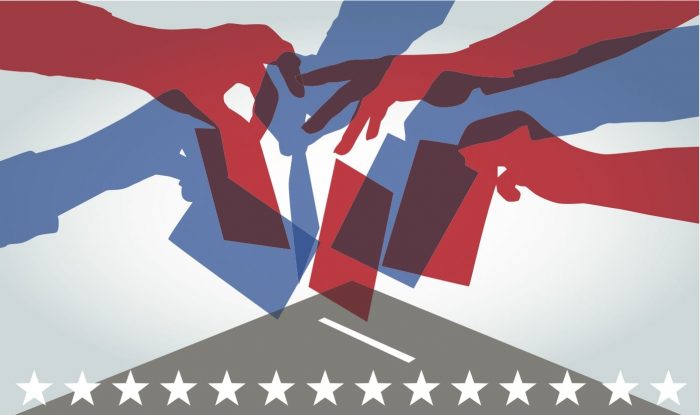By Daniel Dunaief
With the rematch between President Joe Biden, 81, and former President Donald Trump, 78, no longer a possibility, local and national Democrats are tapping into a renewed political energy.
After President Biden announced that he was ending his bid for a second term and endorsed Vice President Kamala Harris, democrats not only contributed a record amount of money to the likely presidential candidate, but also showed more interest in local races.
“People are excited to be a part of something bigger than themselves,” said John Avlon, who is running against Nick LaLota to join the House of Representatives for New York’s 1st Congressional District. “We’ve seen an increase even over typical levels in both volunteerism and donations in the last 24 hours.”
Avlon suggested that the feeling on the ground has changed fundamentally, with Democrats becoming more “fired up” about the prospects in the White House and in the House of Representatives, where toss-up seats like the first congressional district could determine which party has a majority.
A potential repeat of the contested 2020 election had made many democrats uneasy, particularly after a disastrous debate performance by Biden, who validated concerns about his age with awkward silences and uninspiring replies.
The likely ascendance of Vice President Harris, who received endorsements even from those considered potential candidates for president and who has secured enough delegates to be the Democratic nominee, has generated attention and interest among the voting public and has raised the prospect for greater voter turnout in an election that is just over 100 days away.
The change at the top of the ticket provides a “good opportunity to engage voters even beyond the Democratic party,” said Rebecca Kassay, the Democratic candidate for state Assembly District 4, who is running against Republican Ed Flood. She feels the focus on politics from the president to local elections has given her more of an opening to speak with independents and unaffiliated voters and get their thoughts on local issues.
The increased energy and interest around politics, where people in supermarkets, restaurants, gyms and coffee houses are suddenly eager to discuss the changing landscape at the national level, has provided a “great opportunity for local candidates to not have to worry about exciting democrats,” which gives them a chance to reach out to unaffiliated voters and republicans who might consider voting for a democrat, said Keith Davies, Suffolk County Democratic Committee campaign manager.
Davies added that candidates don’t have to spend as much time fielding questions about President Biden’s cognitive abilities.
To be sure, Avlon acknowledged that the political winds, at a local and national level, are bound to blow in different directions as the election approaches.
“There will be good and bad days ahead,” he said. “We shouldn’t over index any one moment.”
Kassay added that the national winds can blow one way or another, with little local control.
Nonetheless, local democratic leaders suggested that this unprecedented decision by an incumbent president, occurring so close to the election, and the immediate effort to rally around Harris and to come together before the Democratic National Convention creates positive momentum.
A new energy
Local democratic politicians appreciated Biden’s efforts to build infrastructure, to lead a coalition to repel Russia’s aggression in the Ukraine and to continue to build jobs in a post-Covid economy.
“There was so much hand wringing because people were saying, at the same time, that Joe Biden did a great job,” but they weren’t confident in his ability to lead for another four years, said Brookhaven Town Councilmember, Jonathan Kornreich. Biden “made this rather courageous decision” to end his campaign.
The effect has been to inspire the democratic political base.
“Everybody who I talked to is energized,” said Steve Englebright, Suffolk County Legislator for the 5th Legislative District. “The implication is that we’ll have enthusiasm and interest, and that will translate into strong turnout.”
Englebright suggested that the number of democratic voters has wider swings in turnout than the number of republican voters, with democrats varying by as much as 30 percent, or more.
Democrats around Suffolk County not only expect higher voter turnout, but also anticipate that more voters would listen to the candidate platforms and make informed decisions.
“There’s a new sense of optimism and that’s palpable,” said Englebright. “That’s going to translate into more people participating and getting involved.”
Higher voter turnout also means that residents can vote on two propositions that will be a part of the 2024 ballot in New York.
The first would add protection against various forms of discrimination, such as sexual orientation, gender identity and pregnancy, to the state constitution. The second would extend and revise the Suffolk County Drinking Water Protection Program. This proposal would establish a Water Quality Restoration Fund, that would be supported by a sales and use tax of 1/8 of a percent.
Female candidates
Democratic leaders were also excited to support the second woman to run for president, after Hillary Clinton’s unsuccessful 2016 campaign against Trump.
“I see the ascension of a democratic candidate at the top of the ticket, who is a woman of color, a woman of substance, in terms of her accomplishments, as validating the idea that women are equally ready” to serve in any political office, said Englebright.
Kassay is excited to be on the same ballot with other women, including Senator Kirsten Gillibrand, state Senate District 1 candidate Sarah Anker and Harris.
“I’m energized and inspired to be running with our first potential female president,” said Kassay. “That, for me, is an honor and historic.”










 With its first celebration in 2012, National Voter Registration Day is a nonpartisan civic holiday dedicated to celebrating the democracy of America. It helps people register to vote and educates communities on the topics at hand, as well as the current office members. Since its inception, more than 5 million Americans have registered.
With its first celebration in 2012, National Voter Registration Day is a nonpartisan civic holiday dedicated to celebrating the democracy of America. It helps people register to vote and educates communities on the topics at hand, as well as the current office members. Since its inception, more than 5 million Americans have registered.








